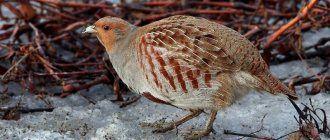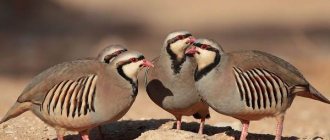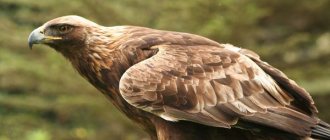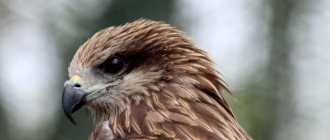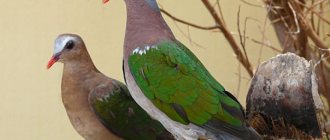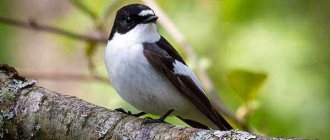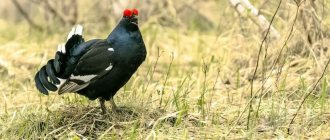The gray partridge is a representative of the Galliformes order from the pheasant family. Ornithologists suggest that this species formed on the territory of the corresponding modern Mongolia and Transbaikalia during the late Pleistocene, that is, about 2.5 million years ago. Later, the bird's range expanded significantly. There is evidence of Neanderthals hunting partridges. Research confirms that ancient people highly valued wild chicken meat and considered it a delicacy. Thus, the partridge has long been an object of hunting for humans.
Distribution and habitats
This species lives throughout almost all of Eurasia in the temperate zone. This bird is most numerous in the steppe and forest-steppe zones; due to deforestation, it has penetrated far into the taiga zone, often nests in the southern part of Karelia, and in some places reaches the White Sea. It is most often found in steppes and grain fields, interspersed with shrubs and copses, in floodplains, in clearings and forest clearings, in the foothills. Prefers vast open spaces, flat or hilly, with ravines overgrown with bushes. Gets along well with people.
Appearance
The bird is small in size and in its general appearance resembles a small, densely built chicken. This wild hen has a camouflage coloration and from a distance appears uniformly gray. The male is grayish-brown above with large light brown transverse stripes on the sides of the body and a dark brown horseshoe-shaped spot on the upper part of the belly. The red head contrasts with the gray back and gray neck. The female is slightly smaller than the male and duller in color. The summer outfit of partridges is brighter and more contrasting.
The weight of adult males ranges from 350-600g, females - 320-570g, depending on the season and subspecies. The smaller bearded partridge is very similar to the gray partridge.
Hunting with a dog
For the hunt to be successful, the dog must strictly follow all the commands of the owner.
Hunting dogs are widely used to hunt the white partridge and its gray brother. This bird knows how to hide and skillfully evade pursuit, which is why pointers and hounds performed well in the hunt. A well-trained and obedient pointer has a keen sense of smell and quickly finds a partridge nesting site. At the owner’s command, the four-legged friend creates a commotion, and the frightened flock begins to scatter. Here the hunter should fire a shot to further scare away the birds. Some of them will immediately take to the wing, thereby becoming easy prey.
As a rule, shot No. 5 or 7 is used for hunting this bird. This shot is used in hunting both ptarmigan and gray bird.
It should be noted that frightened birds scatter in different directions. It is important to follow the direction of their movement in order to make a second shot and double the production.
Lifestyle and social behavior
The gray partridge is an exclusively terrestrial bird and very rarely perches on trees. She runs deftly and maneuverably in thick grass and between bushes. It takes off with great noise and loud flapping of its wings only in case of danger, flies quickly, low above the ground, alternating flapping wings with short glides. Wild chickens fly short distances in the morning and evening in search of new feeding grounds. The partridge runs well, while standing upright, stretching its neck upward and raising its head high, and while walking calmly, it walks with a hunched back and warily surveys its surroundings.
In most places, the gray partridge lives all year round, sometimes making short flights in search of food.
From areas with snowy winters, when ground food becomes unavailable, gray partridges migrate south. The journey of gray partridge flocks begins in the fall and takes place during the daytime. Wild chickens reach the south of Ukraine and the Ciscaucasia, the coast of the Caspian Sea and Central Asia. Some of the population remains to spend the winter.
In winter, gray partridges stay in areas with little snow with thickets of bushes and dry stems of tall plants, in floodplains of rivers, on snowless hills and grain fields. During this harsh time, birds gather in small dense groups. To get food, they dig through snow using their head and beak, throwing it away with their feet and sometimes digging tunnels up to 50 cm in length. If the frosts are not very severe, then partridges spend the night in snowy “dens,” huddled closely together. Sometimes they use the “services” of hares, who dig up the snow to get to the grass. After the hares leave, partridges flock to this place.
In harsh and snowy winters, partridges lose their fear of humans and move closer to housing. Here they can find food and shelter from the cold wind.
Partridges stay in flocks from autumn to spring, and only in March - April during the mating season they break up into pairs.
Gray partridges are hunted by almost all diurnal birds of prey, many mammals, and even eagle owls. Stray dogs and cats cause great damage to the numbers of these birds. Heavy, snowy winters followed by long summer droughts are causing the extinction of gray partridges in some parts of their range. Cold and rainy weather during the hatching period of the chicks can lead to almost complete death. The active use of new agricultural methods, in particular the use of herbicides and pesticides, to which gray partridges are very sensitive, large areas of cereals, devoid of natural shelters, all this adversely affects the number of gray partridges. But due to its high fertility, this species quickly restores its numbers under favorable conditions.
Poultry yard arrangement
It is not recommended to raise pets in cramped cages - being in a confined space, they will experience stress and will not hatch offspring.
The cage, however, has its advantage - the bird enters sexual maturity earlier than in the wild or in an aviary.
The enclosure is made of cotton or nylon mesh with a mesh size of 1x1 cm. The mesh is stretched over a wooden frame at least 2 m high, made of slats (beams). A metal net is not used due to its high rigidity - the bird will be injured.
The area depends on the number of individuals - 0.5-1 sq.m is allocated for each. It is recommended to arrange the interior space to imitate the natural habitat. Sheaves and green spaces located on the ground allow you to achieve your goal. You will need a canopy to protect from direct sunlight and adverse weather.
The meat of this small bird is valued not only by people - dogs, foxes, ferrets and even crows are not averse to eating it. It is important to remember this when organizing an enclosure - it is worth excluding the possibility of predators getting inside. Since the birds, although they fly poorly, run very quickly, you need to make a vestibule at the entrance - otherwise losses cannot be avoided. For “bathing”, boxes with sand are installed, and for feeding, drinking bowls and feeders are installed.
During the cold season, pets are moved to an enclosed space, such as a barn. It is important to ensure that there are no drafts and protection from rodents. The floor in the “winter” room is lined with dry straw - it will have to be changed regularly. As in an open enclosure, a vestibule must be made, and the windows are protected with mesh. A net is also stretched under the ceiling, at a height of 2 m. Troughs with food and water are installed in the room. In winter, artificial lighting is provided, since the lack of light has a bad effect on spring reproduction (the optimal length of daylight hours is 15 hours). Otherwise, partridges are not very demanding - they are unpretentious in keeping at home, have strong immunity, and do not need serious care.
Nutrition and feeding behavior
This wild chicken finds all its food on the surface of the earth and by digging up the soil, just like domestic chickens. The gray partridge feeds on both plant food - seeds of wild and cereal grains, weeds, berries, stems, leaves, nodules and roots, and invertebrate animals, especially in the summer. Small chicks feed on insects in the first two weeks of life. Since partridges consume succulent food in summer, they can go for a long time without a watering hole and feed quite far from water bodies, sometimes at a distance of 10–12 km from the nearest body of water. In winter, the partridge becomes a vegetarian and feeds in areas with little snow.
Vocalization
Gray partridges in flocks look for places with tasty food, and when they find it, they make sounds “gook.gook.gk”, reminiscent of the clucking of chickens. Wary partridges make muffled “coo-kut-kut” noises. As they fly, frightened wild hens cry out anxiously, “chip-chip, chip.chip.kippipipip.” For males, as well as for females, the most typical call is one that sounds like a creaking “chirr” or “chirrik”. Most often, males make this call when they are on some elevation - this is both a signal of location and a threat to the opponent. During the mating season, males, staying in their area, often emit a peculiar cry “kierr-kek”; females at this time make frequent “pit-pit-pit-pit.” Both the female and the male call the chicks with a special clucking sound, reminiscent of a chicken's, but with a sharp increase in tone at the end of each sound. A female disturbed on the nest may hiss threateningly.
Natural enemies
Unfortunately, many animals are enemies of these birds. Almost every four-legged predator does not hesitate to taste its meat, even cats and dogs. Often homeless animals wander through the fields to eat bird chicks or eggs. Partridges and other birds suffer - hawks, kites and crows, which eat both small and large birds. One of the dangers is poachers who destroy birds for profit and meat. While partridges are not in the Red Book, but they are very close.
Reproduction and raising of offspring
In addition to complete molting, during which all feathers are replaced with new ones, the gray partridge also has a partial “pre-nuptial” molting. Partridges prepare for the wedding by exchanging old feathers for beautiful new ones on their necks and heads. Gray partridges are monogamous. At the end of February they begin to split into pairs. The females take the initiative at first. If the flock is a brood that has not broken up since the fall, in which there are last year’s “spouses,” then they again form a pair and retire. Then other females begin to become active and, having chosen a male, leave the flock. Eventually, males left alone join other flocks in the hope of finding a mate. To do this, male gray partridges, as is customary among galliformes, fly up to small elevations even before sunrise and begin to emit a jerky cry that attracts females. Rivals also fly to the call, and then fights break out between the heated gentlemen. Birds choose their spouses meticulously and sometimes change partners several times before making the final choice. The mating ritual is often initiated by the female; she walks towards the male, stretching her neck forward and making wave-like movements with her head and neck. The male stands, stretched vertically upward. Also, gray partridges are characterized by movements when birds, standing close to each other, rub their necks.
After mating, females find or make holes in the ground among dense and tall grasses or shrubs, and line the hole with dry grass. The bird begins to lay eggs only a month after the formation of a pair. The male gray partridge guards the nesting site during the entire incubation period, and after the chicks appear, he takes an active part in their upbringing.
Among all Russian birds, the gray partridge is the most prolific. Starting from the first days of April, during the breeding period, the heroine mother manages to give birth to 12–18 solid yellow-brown eggs (sometimes there are 28 eggs in a clutch!). First, eggs are laid every other day, one after another. Then the interval increases to 2-3 days. And only after laying the last egg, the mother begins selfless incubation for 25 days, and does not take off even when a person appears. She leaves to feed rarely and for a short time. The male does not leave his girlfriend, stays close to the nest and sometimes replaces the female.
Sighted, pubescent light brown chicks hatch together within one day. As soon as the chicks dry out, the female takes them away from the nest, and the brood does not return back to the nest. From the very first hours of life, chickens can run, after a week they begin to flutter little by little, and after two weeks they can already fly quite long distances. As soon as the chicks leave the nest, a male immediately joins the brood and will help lead the brood until the chicks grow up. The brood may not break up until the following spring. At the end of summer, many broods unite into flocks, and young partridges spend the winter in these flocks. By next summer, the chicks become sexually mature.
What to feed chickens?
Fertilized eggs can be hatched by partridges themselves. But you can place the eggs of these birds under chickens or other poultry. And if the farm has an incubator, use it.
During natural incubation, the chicks are kept with their mother for several days, then they are transplanted into a separate cage. Day-old partridges are fed with crushed yolk. The egg is first hard-boiled. On the second day, well-chopped nettles and finely crumbled white bread in a small amount are added to this yolk.
On days 3-4, you can add mealworms, maggots, or undercooked, well-shredded lean meat to the birds' food.
Some poultry farmers manage to kill flies and give this protein food to young partridges. Also, by this age, the chicks are given crushed yarrow, dandelion, and a little cabbage.
The chicks are fed 2 times a day. It is important to provide the young animals with the necessary thermal regime, so that in the first week the ambient temperature is +34 °C. Then it is gradually lowered to +25 °C.
Animal in the Moscow Zoo
Gray partridges have long been kept in the Moscow Zoo. These birds tolerate captivity well and do not create problems in keeping. They quickly get used to humans and can even take food from hands. As food, partridges receive grain mixture, mixed feed, cottage cheese, and sometimes insects. In summer, fresh grass or twigs are placed in the enclosure.
You can see gray partridges at the Moscow Zoo at the “Fauna of Russia” exhibition, where they live in an enclosure together with common pheasants, white hares and small passerine birds. Despite their unpretentiousness, gray partridges do not nest at the exhibition, since the hares, moving around the enclosure, create disturbance, and the birds do not dare to have chicks.
Where does the gray partridge live?
Photo: Gray partridge in Russia
The gray-blue partridge is found almost everywhere throughout the southern and central parts of Russia, Altai, Siberia, in many European countries, including Germany, Great Britain, Canada and North America, and western Asia. The natural habitat is considered to be the southern regions of Western Siberia and Kazakhstan.
Her favorite places:
- dense forest, groves, forest edges;
- meadows with thick, tall grass, open areas with islands of bushes, ravines;
- in some cases, gray partridge willingly settles in marshy areas, but chooses dry islands with dense vegetation.
For the most comfortable conditions, she needs space and the presence of a large number of bushes, tall grass, where she can easily hide, build a nest, and also find food. The partridge often settles near fields with oats, buckwheat, and millet. It helps agriculture by pecking harmful insects and various invertebrates that threaten the crop.
Interesting fact: Having chosen a place to live, gray partridges never leave it. Here, throughout their entire lives, they build nests, raise offspring, and feed; in turn, the grown-up chicks will also remain in the same territory.
Now you know where the gray partridge lives. Let's see what she eats.

